








MIDWEEK UPDATE 3 JUNE 2020   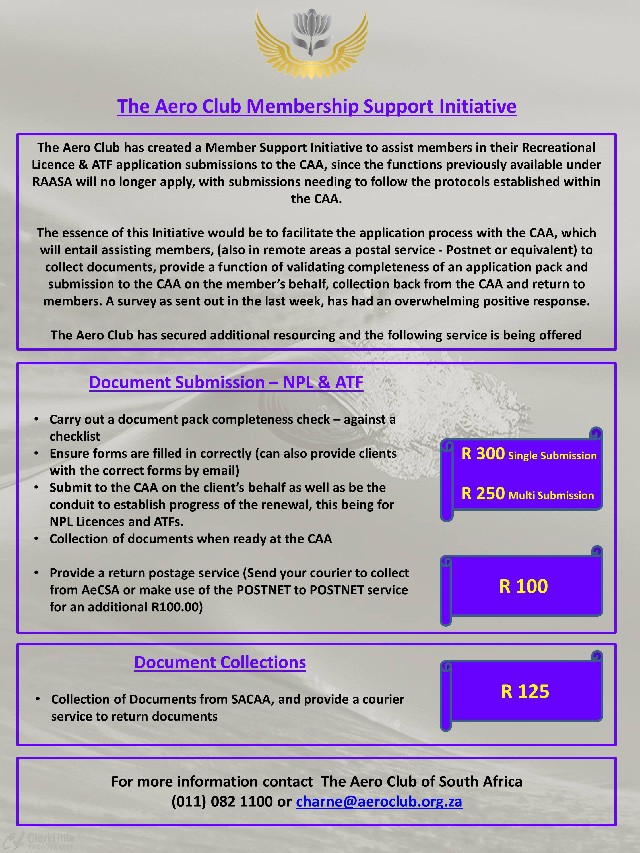  COVID 19 REGULATIONS AND INITIATIVES AND AEROCLUB NEWS AERO CLUB COMMUNIQUE MAY 2020 #7 STATUS ON LIFTING GA / RA FLIGHT RESTRICTIONS IN LEVEL 3 This unfortunately leaves the remainder of GA & RA still grounded for this level, other than the maintenance preservation flights or maintenance positioning/test flights. We have asked the question to at least consider allowance to carry out proficiency flights and will further engage with the DoT / CAA in the coming week on this subject and offer proposals to review if we can enable this. We be keeping all informed of the status of this request. Regarding the Maintenance Preservation Flights the Aero Club / CAASA System has just broken through 1000 registrations with 630 CAA approvals granted and 300 flights completed over the last 9 days. For your reference go to the Aero Club or CAASA websites www.aeroclub.org.za www.caasa.co.za to gain access to the system, the Engine Preservation protocols are also available as provided by the Aero Club ARO AP Panel. If you have any queries regarding this system, contact the Aero Club at office@aeroclub.org.za.  ICASA EXTENDS DUE DATE FOR THE RENEWALS OF RADIO FREQUENCY SPECTRUM LICENCES Independent Communications Authority of South Africa 350 Witch-Hazel Avenue, Eco Point Office Park Eco Park, Centurion. Private Bag X10, Highveld Park 0169 30 March 2020 Pretoria - In view of the state of national disaster and the current 21-day lockdown to curb the spread of the COVID-19 pandemic, the Independent Communications Authority of South Africa (ICASA) has taken a decision to extend the validity period of existing radio frequency spectrum licences in line with regulation 10 of the Radio Frequency Spectrum Regulations. In terms of the regulations, the due date for the renewal of radio frequency spectrum licences is 31 March annually. The regulations further provide that failure to pay the prescribed licence renewal fee by the due date (i.e. 31 March annually), will result in expiry of the radio frequency spectrum licence immediately on the next calendar day that marks the beginning of the new financial year. In this regard, ICASA has resolved to grant all radio frequency spectrum licence holders an extension to renew their licences by no later than the 30th of June 2020.  A week ago, we held our first online AGM thanks to the current prevailing situation and I am glad to announce that it was a great success thus creating a new avenue that is being explored for future events in such times. During the AGM the results of the votes were announced and the new EAA of South Africa Executive Committee is as follows: President - David Toma Vice President - Paul Lastrucci Treasurer - Mark Clulow (who will be assisted by Bradley Stephenson) Secretary - Marie Reddy I would like to thank the outgoing committee for all their efforts during the last year and in true EAA fashion, their amazing offer of assistance for the year to come. With regards to our return to the air from a GA perspective, the discussions and meetings are well on their way thanks to the substantial efforts from the Aero Club as well as several other committees involving heads of AROs and APs. Members of the new Executive Committee are now part of the effort and we shall keep you updated with regards to the progress. As of Monday the 1st of June, flying schools have the green light from the department of transport to resume operations under a CAA approved COVID 19 protocol. In the meantime, we request your patience as we all share your frustrations and desire to get back into the air again. For those who are yet to make use of the continued airworthiness flight permits, please visit the Aero Club or CAASA website in order to apply online. Included on the sites are all the relevant supporting documents for your engine manufacturer that you can use with your application. On a final note, if you ever have any suggestions or comments that you would like to pass on to us, you are welcome to contact me direct on 082 3614 068 or president@eaa.org.za and we will get back to you soonest. Personally, whatsapp messages/sms are easier for me as they fit seamlessly into my day/flying as I am not always able to take calls. I will gladly call back if the situation allows. Till we meet again, stay safe. Kind Regards David B. S. Toma President of EAA of SA   CORONA VIRUS AND AVIATION EVENTS Due to Covid 19 and laws regulating travelling as well as restrictions controlling the number of people congregating together, no aviation events will take place in the foreseeable future. Pilot's Post will advise our readers as soon as this changes.    “While the year started off strongly, the health and safety restrictions put in place to respond to the COVID-19 pandemic began to significantly impact global operations, supply chains and deliveries towards the end of the first quarter. Companies rapidly implemented a wide range of health protocols in accordance with local, regional and national level guidance to keep production, maintenance and training activity churning. Many companies then supplemented ongoing activities with the production and transport of health care materials needed by front line health care workers and communities across the globe. These actions serve as a testament to the adaptability and resilience of our industry's incredible workforce who will play such a pivotal role in our recovery process,” said GAMA President and CEO Pete Bunce. The first quarter of 2020, when compared to the first quarter of 2019, saw piston airplane deliveries decline 11.7%, with 219 units; turboprop airplane deliveries decline 41.8%, with 71 units, and business jet deliveries decline 19.1%, with 114 units. The value of airplane deliveries through the first quarter of 2020 was $3.4 billion, a decline of approximately 21.3%.  Turbine helicopter deliveries for the first quarter of 2020, when compared to the first quarter of 2019, saw a decline of 18.3%, with 85 units and piston helicopter deliveries saw a decline of 43.9%, with 37 units. First Quarter Aircraft Shipments Aircraft Type 2019 2020 Change Piston Airplanes 248 219 -11.7% Turboprop Airplanes 122 71 -41.8% Business Jets 141 114 -19.1% Total Airplanes 511 404 -20.9% Total Airplane Billings $4.3B $3.4B -21.3% Piston Helicopters 66 37 -43.9% Turbine Helicopters 104 85 -18.3% Total Helicopters 170 122 -28.2% Total Helicopter Billings $0.5B $0.4B -19.4%   With E1000 deposits from customers in the U.S., Canada, Mexico, Central and South America, Europe, Russia and South Africa, the company noted its operations are returning to full capacity and it plans to ramp customer deliveries following Covid-19-related setbacks. “The challenges presented by Covid-19 have been unexpected and considerable,” King explained. “But our dedicated staff have persevered, engineered and improvised in order to keep our production lines moving, so we can deliver planes and meet customer expectations.” “Completing these deliveries is a tremendous milestone for our company and our customers,” said Epic CEO Doug King. “The E1000 is a remarkable aircraft and seeing the enthusiasm of our owners as they take delivery is extremely gratifying. This is the successful culmination of eight years of hard work, extensive investment, and a passionate belief in our product.” Bend, Oregon-based Epic's first E1000 delivery was made in February. That airplane has been leased back to Epic for what it said are several “priority” engineering projects. Last week, it delivered the second E1000 after being delayed several times because of the Covid-19 pandemic.   According to magniX and its partner AeroTec, the Grand Caravan is the largest aircraft to have flown with an all-electric propulsion system. The companies are developing the re-engined turboprop single under the name eCaravan and are aiming to achieve certification by the end of 2021. Israeli electric aircraft venture Eviation Aircraft announced in 2019 that it was working with magniX on a nine-seat regional commuter aircraft dubbed Alice. The certification timeline is similar to the others-magniX hopes to have its powerplants in (scheduled) service by 2022. AeroTed has been responsible for replacing the Grand Caravan's 867-shp Pratt & Whitney PT6A turboprop with the magniX propulsion system. It currently draws power from a set of 750-volt lithium-ion batteries weighing around one tonne that need around 30 minutes of charging after a flight of the same duration. The partners estimate that current battery technology would allow the 10- to 14-seat aircraft to carry nine passengers on flights of up to around 100 miles. magniX is also considering lithium-sulphur batteries or hydrogen fuel cells as alternatives that might support longer-range operations. In December, magniX partnered with Vancouver-based operator Harbour Air to fly an all-electric version of the DHC-2 Beaver seaplane. On April 20, Harbour Air reported that it had resumed flight testing of what it calls the eBeaver, having secured approval for take-off, cruise and extended-range performance testing.   Capping off five years of quiet development and testing, Pilatus and the global network of Authorised Pilatus Sales Centres began delivering the new PC 12 NGX advanced single-engine turboprop aircraft to customers around the world. Since its introduction, more than 1,750 PC-12s have been produced, with the venerable single holding the title of the business aviation industry's top-selling pressurised aircraft for the past four years in a row. The first delivery of the PC-12 NGX in the United States went to HP Inc. Director and former CEO, Dion Weisler. Through the Authorised Pilatus Sales and Service Centre Western Aircraft in Boise, Idaho, Weisler upgraded to the new model from his 2017 model year PC-12 NG, ordering his NGX as soon as Pilatus opened the order book last October. Additional PC-12 NGX launch customers from Brazil and the United States will be taking delivery of their new aircraft end of May and in June 2020. The new PC-12 NGX is powered by the first Full Authority Digital Engine Control (FADEC) in a business turboprop aircraft. The PT6E-67XP engine on the PC 12 NGX features Pratt & Whitney Canada's patented Electronic Propeller and Engine Control System (EPECS). This solid-state, dual-redundancy control system simplifies engine start, reduces pilot workload and enables an unprecedented level of performance control and monitoring. While the PC 12 NGX's engine is still thermodynamically rated at 1,845 shaft horse power (shp), the EPECS allows cruise flat-rated power to be increased ten percent to 1,100 shp, and extends the time between overhaul by 42 percent to 5,000 hours. The maximum cruise speed of the PC-12 NGX is 290 knots (537 km/h), an increase of 30 knots (55 km/h) on the original model. Pilot workload is further reduced by the incorporation of single power lever and a fully-integrated auto-throttle option on the PC-12 NGX, another first in a business turboprop aircraft. In addition to the new engine and control system, the PC-12 NGX features an all-new passenger cabin inspired by Pilatus' PC-24 Super Versatile Jet. All-new seats, larger windows, indirect LED lighting and a new air distribution system all contribute to a more modern, refined, comfortable passenger experience. The new engine technology also features a Propeller Low Speed mode, reducing the propeller speed from 1,700 to 1,550 revolutions per minute - dramatically reducing cabin noise levels with virtually no reduction in performance.  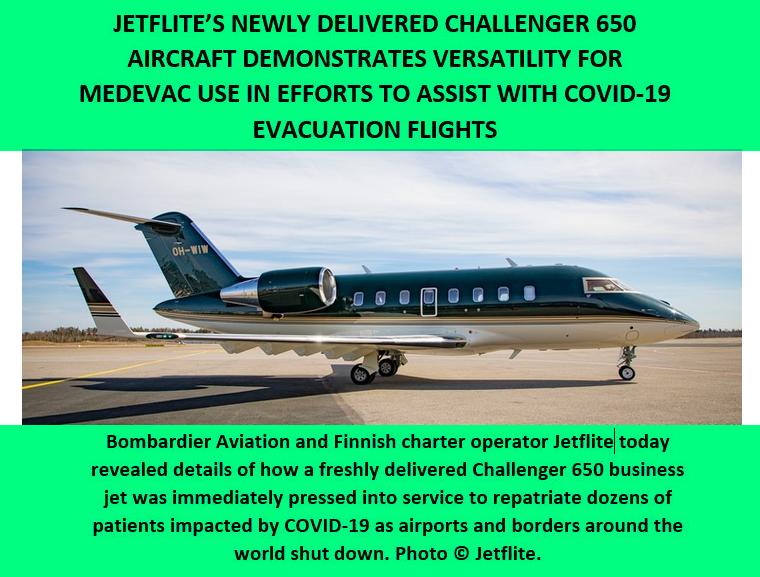 The aircraft, configured for executive charter service, was delivered to long-time Bombardier customer Wihuri Group, a large Finnish industrial conglomerate. The aircraft is operated by Jetflite, which is owned by Wihuri Group. The unique adaptability of the Challenger 650 aircraft interior allows Jetflite to quickly transform the business jet's 12-to-16-passenger VIP configuration to an air ambulance configuration, complete with two stretchers, a portable isolation unit, personal protective equipment, COVID-19 test kits and a medical team to respond effectively to the growing worldwide humanitarian crisis. “Our Jetflite fleet is always busy, but completing the first 100 hours inside 14 days directly out of the factory was something of a record, even for us, particularly in light of the challenges in flight route planning, obtaining diplomatic clearances and booking risk-free crew accommodation during the spread of COVID-19,” said Elina Karjalainen, Managing Director, Jetflite. “We are very proud to have this impressive new aircraft in our fleet and to be able to help so many people, as we wait for better days ahead.” On its longest tour, the aircraft traversed three continents in five days, flying from its base in Helsinki, Finland, to Portugal, Italy, Mali, Canary Islands, Liberia, South Africa, Seychelles, Afghanistan and Estonia to repatriate citizens to their home countries. “The importance of reliability and flexibility, for which our Challenger platform is legendary, is brought into sharper focus when lives are on the line,” said David Coleal, President, Bombardier Aviation. “We are extremely proud that our Challenger 650 aircraft is able to make a strong contribution to the important humanitarian work the Jetflite team is doing.” The same qualities that make the Challenger 650 jet an ideal business tool also make the aircraft an excellence choice as a next-generation air ambulance. In addition to its quiet and widest-in-class cabin, outstanding short-field performance and impressive range of 4,000 nm (7,408 km), the Challenger 650 aircraft offers an exceptionally smooth ride - its advanced wing design promotes greater patient comfort from take-off to touchdown.  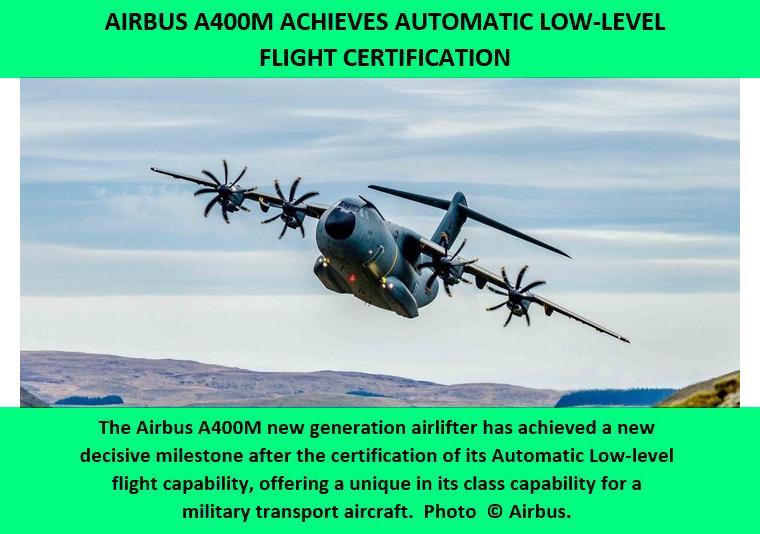 This first certification phase concerns operations with Visual Meteorological Conditions, meaning with crew visibility. There will be a second phase including Instrumental Meteorological Conditions, without visibility, to be certified in Q2 2021. Inherent to the fighter aircraft world, and as a unique capability for a military transport aircraft, the Automatic Low Level Flights improves the A400M's terrain masking and survivability, making the aircraft less detectable in hostile areas and less susceptible to threats when cruising towards key military operations like aerial delivery, air-to-air refuelling, logistic or other specific special operations.  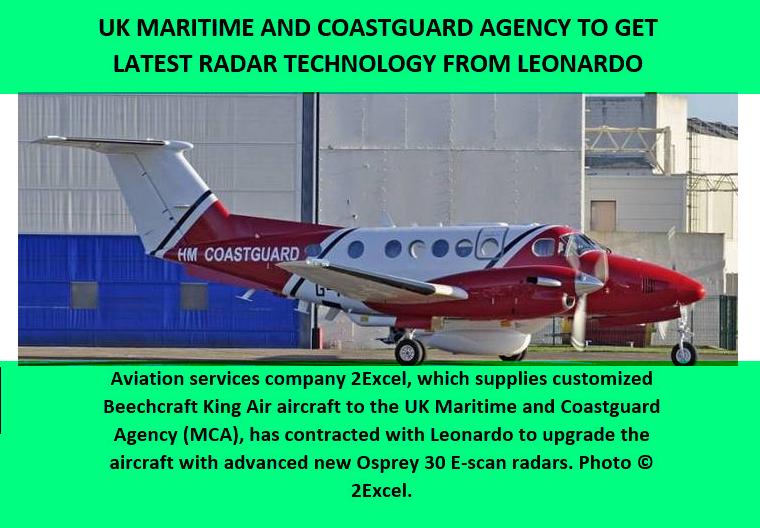 The UK Maritime and Coastguard Agency (MCA) will upgrade to Leonardo's latest Osprey radar to support missions such as search and rescue, border protection, fishery and pollution patrols. The Osprey 30 radar will be installed on-board the two customised Beechcraft King Air aircraft provided to the UK MCA by UK-based aviation services company 2Excel. Currently, the UK MCA is operating Leonardo's Seaspray 7300E radar, which has been employed to great effect in support of regular fishery and pollution patrols around the UK. The radar comes equipped with Leonardo's patented small target detection capability, allowing it to spot shipwrecked individuals in the water at long range, even in the most difficult environmental conditions and sea states. Additionally, the radar provides the ability for MCA crews to identify oil spills and rogue polluters at very long range, day or night. 2Excel will build on this success by equipping the MCA King Airs with Leonardo's second-generation Osprey radar, the latest entry in its range of E-scan surveillance radars. Osprey benefits from all of the capabilities of the Company's Seaspray family while also adding additional modes and optimized overland and coastal imaging capabilities. This makes the radar ideally suited to mixed environment operations, such as along the coast. Traditionally, coastguard aircraft have used radars with restricted fields of view and limited detection capabilities, making searches laborious and resource-intensive. Leonardo's radars solve these problems. The company is a world leader in E-scan, also known as AESA (Active Electronically-Scanned Array) technology, which uses a matrix of hundreds of tiny radar modules to 'steer' an electronic beam, rather than mechanically moving the radar to point at a target. With a Leonardo E-Scan radar, crews can lift off, scan in 360 degrees and almost-instantaneously detect, track and classify hundreds of maritime contacts, allowing crews to quickly task cooperating aircraft to deeply search an area of interest. Other E-scan advantages include extremely high reliability, as the radar can continue to operate effectively throughout a mission even if a number of its individual radar modules fail. Customers in 30 countries have selected Leonardo's E-scan radars including the Seaspray and Osprey families, with the US Navy procuring the Osprey 30 radar for its Fire Scout unmanned helicopter programme.  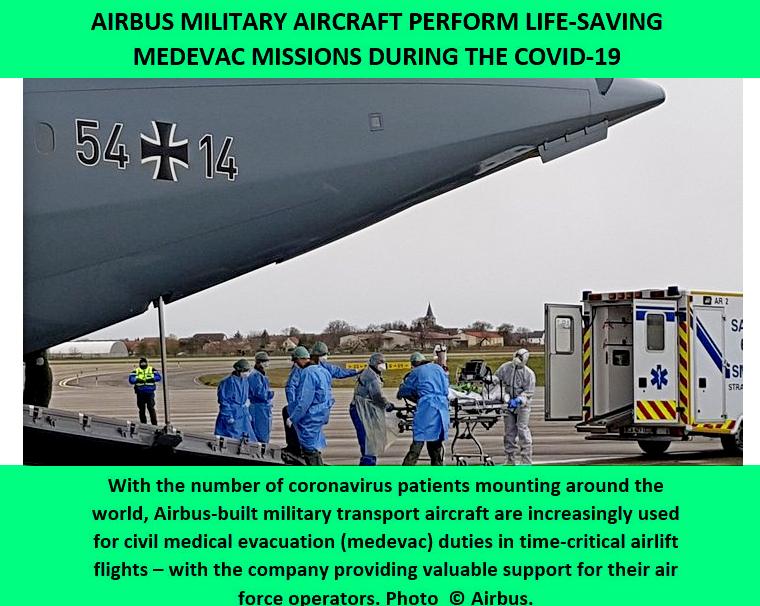 The UK Royal Air Force (RAF) has deployed an A400M on three medical evacuation CCAST (Critical Care Air Support Team) missions so far, transporting patients from the Scottish Islands - where there is an outbreak of COVID-19 and limited health facilities to cope with it - to mainland hospitals for emergency treatment. Designed for global strategic and tactical air transport as well as humanitarian missions, Airbus' four-engine, turboprop-powered A400M has the range, speed, operating altitude, and cabin environment to optimally serve the medical evacuation role. For CCAST applications, the aircraft utilises up to three specially-designed frames in the cargo hold to carry critically ill patients - each providing full intensive care capabilities in the air. This unique configuration, coupled with the aircraft's ability to fly at near jet speeds and land on very short or unprepared runways, makes it the optimal solution for medical evacuations from the UK's outlying islands. The UK's A400M fleet is backed by Airbus through a long-term global support service contract, with a company team based at RAF Brize Norton air base in Oxfordshire, UK - working hand-in-hand with the RAF to ensure operational availability 365 days a year. “Flying these missions is of national importance in helping the NHS safeguard the health of every person in the United Kingdom - even in its most remote corners,” explained Ian C.???, the Maintenance Operations Coordinator. “We anticipate more critical missions in the coming weeks as this crisis progresses, and it is crucial that we deliver 100% mission success.” The French Air Force also has deployed A400Ms from its fleet for COVID-19-related medical evacuations, with the country's first-delivered aircraft now transporting patients from congested hospitals within France to areas with greater critical healthcare capacity - complementing the military service's A330 MRTT, also being used in this role. The A400M was converted for medical evacuations using a configuration rapidly developed by the French military aeronautical research and test centre (Centre d'Expertise Aérienne Militaire) - applying certain elements of the CM30 medical evacuation module used in the A330 MRTT - and completed in record time. “The high speed of execution was possible thanks to a study we had carried out in 2018, along with the excellent work and strong commitment from Airbus teams,” said the French Air Force officer in charge. “The trust and proximity we've built with Airbus over the years really helped us solve technical questions very quickly.” Soon after its conversion, the A400M transported four COVID-19 patients from Ile-de-France to Clermont-Ferrand early this month - and went on to perform three more medevac missions over the following two-day period.   The Air Force said that the bomber missions are designed to allow aircrew to become acquainted with air bases, airspace and operations at various geographic combatant commands and also strengthen relationships with NATO allies.  Available free on the web new content is published twice a week and now in its ninth year of publication, www.pilotspost.com is the most cost-effective aviation advertising medium available. Averaging more than 600,000 hits per month from almost 50,000 unique readers across all spectrums of the aviation industry your advert will reach your target market. Pilot's Post is also the official media channel for the Aero Club of South Africa whose more than 3400 members, that forms part of your target market, are kept abreast on a weekly basis of all events and news regarding the club and the aviation industry in general. Advertising with Pilot's Post is cost-effective and affordable to all. Unique to Pilot's Post is our video advertising packages. Our monthly electronically generated advertising statistic report show advertisers the number of times their advertisements were displayed and the number of times they were clicked by readers to access the advertisers website, information that allow you to track the effectiveness of your advertising. Advertisements in our publication are displayed within the content pages readers are focussing on and it is not stashed away in a commercial section potentially ignored by most readers. Three types of advertisements are included with each advertising package to suit the different types of content and to ensure that you are covered regardless of the content type readers are accessing. Adverts are displayed on a rotational basis together with other advertisers on a ratio linked to the advertising package options. Advertiser also are allowed to post adverts of their products on our Facebook group page that currently has almost 7000 members. Our Midweek update are there to inform our readers about all developments in the aviation industry and advertisers are encouraged to make use of it to keep clients informed of developments and special offers on products. We will create the advertisements at no additional cost depending on the package type or duration of your order and offer up to 20% discount on packages of six months and longer. For more information please contact us at info@pilotspost.com     Russia, Anadyr Airport: A Russian Air Force Mil Mi-8 began spinning uncontrollably during take-off from Anadyr Airport, Russia. The aircraft crashed and burst into flames, killing the three crew members and engineer.    Australian aviator Charles Ulm was the relief pilot. The other crewmen were Americans:- James Warner, the radio operator and Captain Harry Lyon, the navigator and engineer The flight was in three stages. The first, from Oakland to Wheeler Army Airfield, Hawaii, was 3,870 kilometres (2,400 mi), taking an uneventful 27 hours 25 minutes (87.54 mph). They took off from Barking Sands on Mana, Kauai, since the runway at Wheeler was not long enough. They headed for Suva, Fiji, 5,077 kilometres (3,155 mi) away, taking 34 hours 30 minutes (91.45 mph). This was the most demanding section of the journey, as they flew through a massive lightning storm near the equator. The third leg was the shortest, 2,709 kilometres (1,683 mi) and was completed in 20 hours (84.15 mph). The crew crossed the Australian coastline near Ballina before turning north to fly 170 kilometres (110 mi) to Brisbane, where they landed at 10.50 a.m. on 9 June. The total flight distance was approximately 11,566 kilometres (7,187 mi). Kingsford Smith was met by a huge crowd of 26,000 at Eagle Farm Airport and received a hero's welcome Kingsford Smith and co-pilot John Thompson "Tommy" Pethybridge were flying the Lady Southern Cross overnight from Allahabad, India, to Singapore, as part of their attempt to break the England-Australia speed record held by C. W. A. Scott and Tom Campbell Black, when they disappeared over the Andaman Sea in the early hours of 8 November 1935.  |
                            |
 |
 |

Copyright © Pilot's Post PTY Ltd
The information, views and opinions by the authors contributing to Pilot's Post are not necessarily those of the editor or other writers at Pilot's Post.